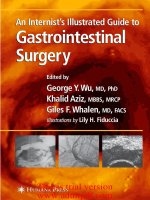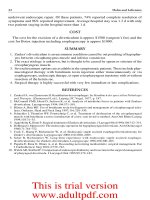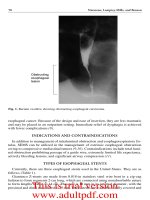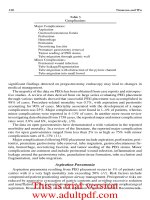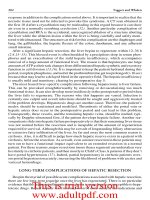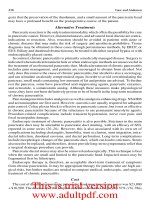Ebook Lippincott illustrated reviews flash cards Physiology Part 1
Bạn đang xem bản rút gọn của tài liệu. Xem và tải ngay bản đầy đủ của tài liệu tại đây (19.75 MB, 206 trang )
Lippincott Illustrated Reviews Flash Cards
PHYSIOLOGY
Robin R. Preston, PhD
Preston_FM.indd i
5/3/14 3:58 AM
Acquisitions Editor: Crystal Taylor
Product Development Editor: Stephanie Roulias
Production Project Manager: David Orzechowski
Design Coordinator: Holly McLaughlin
Illustration Coordinator: Doug Smock
Manufacturing Coordinator: Margie Orzech
Prepress Vendor: Absolute Service, Inc.
Copyright © 2015 Wolters Kluwer Health
All rights reserved. This book is protected by copyright. No part of this book may be reproduced or transmitted in any form or by any means, including as photocopies or scanned-in or other
electronic copies, or utilized by any information storage and retrieval system without written permission from the copyright owner, except for brief quotations embodied in critical articles and
reviews. Materials appearing in this book prepared by individuals as part of their official duties as U.S. government employees are not covered by the above-mentioned copyright. To request
permission, please contact Wolters Kluwer Health at Two Commerce Square, 2001 Market Street, Philadelphia, PA 19103, via email at , or via our website at lww.com
(products and services).
987654321
Printed in China
978-1-4511-9106-6
1-4511-9106-5
Library of Congress Cataloging-in-Publication Data is available upon request
Care has been taken to confirm the accuracy of the information presented and to describe generally accepted practices. However, the author(s), editors, and publisher are not responsible
for errors or omissions or for any consequences from application of the information in this book and make no warranty, expressed or implied, with respect to the currency, completeness, or
accuracy of the contents of the publication. Application of this information in a particular situation remains the professional responsibility of the practitioner; the clinical treatments described
and recommended may not be considered absolute and universal recommendations.
The author, editors, and publisher have exerted every effort to ensure that drug selection and dosage set forth in this text are in accordance with the current recommendations and
practice at the time of publication. However, in view of ongoing research, changes in government regulations, and the constant flow of information relating to drug therapy and drug reactions,
the reader is urged to check the package insert for each drug for any change in indications and dosage and for added warnings and precautions. This is particularly important when the
recommended agent is a new or infrequently employed drug.
Some drugs and medical devices presented in this publication have Food and Drug Administration (FDA) clearance for limited use in restricted research settings. It is the responsibility
of the health care provider to ascertain the FDA status of each drug or device planned for use in his or her clinical practice.
Preston_FM.indd ii
5/23/14 1:05 AM
Features: Three-Step Review
SPOT FLASH
Test your grasp of key concepts or equations on a lecture-bylecture basis!
COURSE REVIEW
In-depth questions to ensure a thorough understanding of
course material. High-yield facts for Course- and Boardexam review!
CLINICAL CORRELATIONS
Explain how the basic science helps predict outcomes in a
clinical setting!
Featuring the same visionary artwork found in
Lippincott Illustrated Reviews: Physiology
With Lippincott Illustrated Reviews, Seeing is Understanding.
Lippincott Illustrated Reviews Flash Cards: Physiology
Preston_FM.indd iii
Copyright © 2015 Wolters Kluwer
5/3/14 3:58 AM
Preston_FM.indd iv
5/3/14 3:58 AM
Preface
Lippincott Illustrated Reviews Flash Cards: Physiology is a portable study tool designed for self-assessment and review
of medical physiology. The flash cards were developed primarily for use by medical students studying physiology and
preparing for course and U.S. medical licensing exams, but information is presented with a clarity and level of detail
that suits them as supplements for any of the allied health sciences. The deck contains two card types: Question (Q)
cards and Summary cards.
Q CARDS
The majority of cards comprise Q cards that prompt the reader with questions to assess level of understanding and depth
of knowledge.
Each Q card contains three-tiered questions or sets of questions on a common topic: The first tests for retention of basic
facts, whereas the next two build on the basics to test understanding of concepts and clinical presentations. The three
question types are denoted by icons.
SPOT FLASH: Questions test your grasp of key facts or equations and are intended for use on a lecture-by-lecture
assessment and review basis.
COURSE REVIEW: In-depth questions ensure a thorough understanding of concepts that may have been revisited
several times during a medical physiology course. The answers focus on high-yield facts to help consolidate
memory during course- and licensing-exam review.
CLINICAL CORRELATIONS: Underscoring how the basic science helps predict outcomes in a clinical setting, these
correlations are particularly useful when studying for licensing exams, but sneak peeks can encourage students
to persevere during early physiology lectures!
Continued, over
Lippincott Illustrated Reviews Flash Cards: Physiology
Preston_FM.indd v
Copyright © 2015 Wolters Kluwer
5/3/14 3:58 AM
Preface
Q cards include several features to aid learning and memorization:
• Illustrations: Richly detailed illustrations from the popular companion text, Lippincott’s Illustrated Reviews:
Physiology, appear on both sides of the cards. Many of the illustrations include narrative boxes to help guide
readers through complex concepts.
• A-plus: Answers may be supplemented with information that goes beyond the need-to-know basics to provide
context or to enrich and help cement a medical concept.
• Emphasis: Key terms and diseases are bolded for rapid review and assimilation.
SUMMARY CARDS
Summary cards follow a more traditional flash card design, taking readers step-by-step through a complex physiologic
regulatory pathway.
The card deck is designed to be comprehensive, covering all significant physiologic
concepts. Key equations are additionally summarized in an appendix for quick and easy
reference.
Note: Our knowledge and understanding of human physiology evolves constantly in the light of new
research discoveries. Future editions of Lippincott Illustrated Reviews Flash Cards: Physiology will be
updated to take into account such findings and to respond to user feedback. If you have any comments or
suggestions for improvement, please contact the author at
Lippincott Illustrated Reviews Flash Cards: Physiology
Preston_FM.indd vi
Copyright © 2015 Wolters Kluwer
5/3/14 3:58 AM
Figure Credits
Card 1.1 Question and Answer:
Modified from Chandar N, Viselli, S.
Lippincott’s Illustrated Reviews: Cell
and Molecular Biology. Philadelphia,
PA: Lippincott Williams & Wilkins;
2010.
Card 1.5 Question and Answer:
Modified from Clarke MA, Finkel R,
Rey JA, et al. Lippincott’s Illustrated
Reviews: Pharmacology. 5th ed.
Philadelphia, PA: Lippincott
Williams & Wilkins; 2012.
Card 2.7 Question and Answer,
Card 2.15 Question and Answer,
Card 2.18 Question and Answer,
Card 2.25 Question and Answer,
Card 2.29 Question and Answer:
Modified from Krebs C, Weinberg J,
Akesson E. Lippincott’s Illustrated
Review of Neuroscience. Philadelphia,
PA: Lippincott Williams & Wilkins;
2012.
Lippincott Illustrated Reviews Flash Cards: Physiology
Preston_FM.indd vii
Card 2.5 Question and Answer:
Modified from Moore KL, Dalley AF.
Clinical Oriented Anatomy. 4th ed.
Philadelphia, PA: Lippincott
Williams & Wilkins; 1999.
Card 2.14 Question and Answer and
Card 2.20 Question and Answer:
Modified from Bear MF, Connors BW,
Paradiso MA. Neuroscience:
Exploring the Brain. 3rd ed.
Philadelphia, PA: Lippincott
Williams & Wilkins; 2007.
Card 2.31 Question and Answer:
Modified from Siegel A, Sapru HN.
Essential Neuroscience. 2nd ed.
Philadelphia, PA: Lippincott
Williams & Wilkins; 2011.
Card 3.7 Question and Answer:
Data modified from Kuo KH,
Seow CY. Contractile filament
architecture and force transmission
in swine airway smooth muscle.
J Cell Sci. 2004;117:1503–1511.
Card 3.10 Question and Answer:
Model (lower) modified from Thurner
PJ. Atomic force microscopy and
indentation force measurement of
bone. Nanomed. Nanobiotechnol.
2009;1:624–629.
Card 4.1 Question and Answer,
Card 4.2 Question and Answer,
Card 4.10 Question and Answer, and
Card 4.11 Question and Answer:
Modified from Klabunde RE.
Cardiovascular Physiology Concepts.
Philadelphia, PA: Lippincott
Williams & Wilkins; 2005.
Card 4.30 Question and Answer:
Data modified from Harper AM.
The inter-relationship between
aPco-2 and blood pressure in the
regulation of blood flow through the
Copyright © 2015 Wolters Kluwer
5/3/14 3:58 AM
Figure Credits
cerebral cortex. Acta Neurol Scand
Suppl. 1965;14:94.
Philadelphia, PA: Lippincott
Williams & Wilkins; 2005.
Card 4.31 Question, Card 6.2 Question and Answer, Card 6.5 Question
and Answer, and Card 9.1 Question
and Answer: Modified from Rhoades
RA, Bell DR. Medical Physiology.
3rd ed. Philadelphia, PA: Lippincott
Williams & Wilkins; 2009.
Card 5.13 Question and Answer,
Card 5.14 Question and Answer,
Card 8.3 Question and Answer, and
Card 9.15 Question and Answer:
Modified from Harvey RA, Ferrier DR.
Lippincott’s Illustrated Reviews:
Biochemistry. 5th ed. Philadelphia,
PA: Lippincott Williams & Wilkins;
2011.
Card 5.1 Question and Answer,
Card 5.5 Question and Answer,
Card 5.7 Question and Answer,
Card 5.18 Question and Answer,
Card 6.28 Question and Answer,
Card 6.29 Question and Answer,
Card 6.30 Question and Answer, and
Card 6.31 Question and Answer:
Modified from West JB. Respiratory
Physiology: The Essentials. 7th ed.
Lippincott Illustrated Reviews Flash Cards: Physiology
Preston_FM.indd viii
Card 6.9 Question and Answer: Data
modified from Rector FC. Sodium,
bicarbonate, and chloride absorption
by the proximal tubule. Am J Physiol.
1983;244:F461–F471.
Card 8.8 Question and Answer:
Modified from Rubin E, Farber JL.
Pathology. 3rd ed. Philadlephia,
PA: Lippincott Williams & Wilkins;
1999.
Card 8.17 Question and Answer:
Modified from Anatomical Chart
Company. Philadelphia, PA: Wolters
Kluwer Health, 2013.
Card 9.5 Question and Answer:
Modified from West JB. Best and
Taylor’s Physiological Basis of
Medical Practice. 12th ed. Baltimore,
MD: Williams & Wilkins; 1991.
Card 9.14 Question and Answer:
Yochum TR, Rowe LJ. Yochum
And Rowe’s Essentials of Skeletal
Radiology. 3rd ed. Philadelphia,
PA: Lippincott Williams & Wilkins;
2004.
Copyright © 2015 Wolters Kluwer
5/3/14 3:58 AM
Contents
UNIT 1
Principles of Physiologic Function
1.1
UNIT 2
Sensory and Motor Systems
2.1
UNIT 3
Musculoskeletal and Integumentary Systems
3.1
UNIT 4
Cardiovascular System
4.1
UNIT 5
Respiratory System
5.1
UNIT 6
Urinary System
6.1
UNIT 7
Gastrointestinal System
7.1
UNIT 8
Endocrine System
8.1
UNIT 9
Living and Dying
9.1
Key Equations and Abbreviations
A-1
APPENDIX
Lippincott Illustrated Reviews Flash Cards: Physiology
Preston_FM.indd ix
Copyright © 2015 Wolters Kluwer
5/3/14 3:58 AM
Preston_FM.indd x
5/3/14 3:58 AM
1.1 Question
Membrane Proteins
What two protein classes are indicated by boxed numerals?
Extracellular
fluid
2
What is a GPI-anchored protein?
What hemolytic disease is caused by a GPI synthetic
pathway defect?
Intracellular
fluid
Lippincott Illustrated Reviews Flash Cards: Physiology
Preston_Unit01.indd 1
1
Cytoskeleton
Copyright © 2015 Wolters Kluwer
5/2/14 8:22 PM
1.1 Answer
Membrane Proteins
Two protein classes:
1. Peripheral: Peripheral proteins localize to the
membrane surface and may be weakly associated.
2. Integral: Integral proteins span the width of the
membrane, penetrating the lipid core.
Extracellular
fluid
2
GPI-anchored proteins are a subclass of peripheral
membrane proteins attached to the cell exterior. They are
anchored within the plasma membrane by a glycolipid
(i.e., GPI) that is attached during posttranslational
modification.
A-plus: GPI-anchored proteins include surface antigens,
cell adhesion molecules, receptors, and hydrolytic enzymes
(e.g., acetylcholinesterase and alkaline phosphatase).
Intracellular
fluid
1
Cytoskeleton
Paroxysmal nocturnal hemoglobinuria results from
mutations in the PIG-A gene. PIG-A is required for GPI
anchor synthesis. The defect leaves RBCs susceptible to the
actions of complement, resulting in a hemolytic anemia.
Lippincott Illustrated Reviews Flash Cards: Physiology
Preston_Unit01.indd 2
Copyright © 2015 Wolters Kluwer
5/2/14 8:22 PM
Diffusion
1.2 Question
Define the equation used to determine the rate at which molecules diffuse
through gases or solutions.
Describe how the cardiovascular, GI, and respiratory systems take advantage
of the Fick law.
Water
Why might celiac disease be considered a “Fick law defect”?
Simple diffusion of a blue dye through water.
Lippincott Illustrated Reviews Flash Cards: Physiology
Preston_Unit01.indd 3
Copyright © 2015 Wolters Kluwer
5/2/14 8:22 PM
1.2 Answer
Diffusion
Diffusion rates (J) can be calculated using a derivation of the Fick law of
diffusion:
J ϭ P ϫ A (C1 Ϫ C2)
Water
Where P is a permeability coefficient, A is surface area, and C1 Ϫ C2
is the concentration gradient driving diffusion.
The cardiovascular, GI, and respiratory systems all take advantage of the
Fick law by maximizing diffusion rates through surface area amplification
(A). [Note: The lungs also maximize diffusion rates by using an air–gas
interface of Ͻ0.3 mm (thickness is a component of the permeability
coefficient, P) and by maintaining the concentration gradients for both O2
and CO2 through ventilation and high blood flow.]
Celiac disease might be considered a “Fick law defect” insofar as villar
atrophy reduces small intestine surface area. Atrophy is caused by gluteninduced intestinal inflammation. The disease is typified by chronic diarrhea
and weight loss from impaired nutrient absorption.
Simple diffusion of a blue dye through water.
Lippincott Illustrated Reviews Flash Cards: Physiology
Preston_Unit01.indd 4
Copyright © 2015 Wolters Kluwer
5/2/14 8:22 PM
Membrane Transport
1.3 Question
What are the three principal modes of carrier-mediated membrane
transport (one example is shown)?
What is an ion pump? What are the three principal pumps found in
humans, and how are they distributed?
Cardiac glycosides (e.g., digoxin) may be used to improve output
of a heart with systolic dysfunction by what mechanism?
Plasma
membrane
Lippincott Illustrated Reviews Flash Cards: Physiology
Preston_Unit01.indd 5
Copyright © 2015 Wolters Kluwer
5/2/14 8:22 PM
1.3 Answer
Membrane Transport
Three modes of carrier-mediated membrane transport:
1. Facilitated diffusion
2. Primary active transport
3. Secondary active transport
• Exchangers (cotransporters or antiports)
• Cotransporters (symports)
An ion pump is a primary active transporter that uses ATP to
pump ions “uphill” against their electrochemical gradient. The
three principal pumps in humans are:
• Naϩ-Kϩ ATPase (ubiquitous: creates the Naϩ gradient used
to power secondary active transport)
• Ca2ϩ ATPase (ubiquitous: keeps intracellular Ca2ϩ levels
low)
• Hϩ-Kϩ ATPase (found primarily in the stomach and in
osteoclasts)
Digoxin and other glycosides improve inotropy by inhibiting the
Naϩ-Kϩ ATPase and raising intracellular Naϩ. This weakens the
gradient driving Ca2ϩ extrusion via the Naϩ-Ca2ϩ exchanger and
raises intracellular Ca2ϩ. Because Ca2ϩ equates with cross-bridge
cycle numbers, myocardial inotropy and output are improved.
Lippincott Illustrated Reviews Flash Cards: Physiology
Preston_Unit01.indd 6
Primary active transport
Example: Ca2+ ATPase
Ca2+
The carrier is an ATPase
that uses energy to
move Ca2+ against its
concentration gradient.
Plasma
membrane
Ca2+ ATPase
Copyright © 2015 Wolters Kluwer
5/2/14 8:22 PM
Intercellular Communication
1.4 Question
What are the four principal modes of intercellular communication?
What are the main advantages to chemical communication between cells?
Male patients who are infertile may receive a serum sex hormone–binding
globulin (SHBG) test. What is the function of SHBG normally?
Chemical
message
Blood
vessel
Target cell
Lippincott Illustrated Reviews Flash Cards: Physiology
Preston_Unit01.indd 7
Receptor
Copyright © 2015 Wolters Kluwer
5/2/14 8:22 PM
1.4 Answer
Intercellular Communication
Four modes of intercellular communication:
1. Direct contact (via gap junctions)
2. Hormonal signaling (via blood)
3. Paracrine signaling (close proximity signaling)
4. Autocrine signaling (provides a feedback pathway that acts on the
cell originating the signal)
Advantages to chemical communication include:
• Economy: Chemical signals can reach every cell in the body via
blood. Electrical signaling, by contrast, requires a dedicated network
of nerves.
• Signal gain: Chemical signals can be amplified (e.g., by hormonestimulating hormones) en route, whereas electrical signals degrade
with distance.
SHBG is a plasma glycoprotein that binds androgen and estrogens with
high affinity. SHBG and related proteins help transport hormones to their
target, increase their half-lives, and determine bioavailability. Because
SHBG levels control testosterone access to tissues, an inappropriate rise in
serum SHBG can cause symptoms similar to hypogonadism.
Lippincott Illustrated Reviews Flash Cards: Physiology
Preston_Unit01.indd 8
Chemical
message
Blood
vessel
Target cell
Receptor
Copyright © 2015 Wolters Kluwer
5/2/14 8:22 PM
1.5 Question
Intracellular Signaling
What are the five numbered components of the signal transduction pathway
shown?
1
What is the function of cAMP in this pathway?
Vibrio
causes a watery diarrhea through upregulation of the cAMP
signaling pathway and
efflux via the
(CFTR).
3
2
β
γ
5
ATP
α
4
cAMP + PPi
Lippincott Illustrated Reviews Flash Cards: Physiology
Preston_Unit01.indd 9
Copyright © 2015 Wolters Kluwer
5/2/14 8:22 PM
1.5 Answer
Intracellular Signaling
Five components of the cAMP signal transduction pathway:
1. Hormone or neurotransmitter
2. Receptor
3. GTP-binding protein
4. GTP
5. Active AC
cAMP functions as a second messenger that couples receptor activation
with intracellular effectors such as PKA. [Note: The advantage to using
second messenger systems is that they allow for massive signal amplification. The cAMP pathway is one of two principal effector pathways in cells.
The other uses IP3 as second messenger.]
1
3
2
β
γ
5
ATP
α
4
Vibrio cholerae causes a watery diarrhea through upregulation of the cAMP
signaling pathway and ClϪ efflux via the cystic fibrosis transmembrane
conductance regulator (CFTR). [Note: Cholera toxin stimulates ADPribosylation and irreversible activation of G␣s, thereby upregulating PKA.
PKA then activates CFTR, causing ClϪ (and obligated water) secretion into
the gut lumen.]
cAMP + PPi
A-plus: cAMP pathway upregulators can be remembered using cAMP as a
mnemonic. Cholera, anthrax, E. coli (mentally rotate the E 90° to make it an
M), and pertussis toxins all upregulate the cAMP pathway.
Lippincott Illustrated Reviews Flash Cards: Physiology
Preston_Unit01.indd 10
Copyright © 2015 Wolters Kluwer
5/2/14 8:22 PM
1.6 Question
Equilibrium Potentials
What is the equation used to calculate an ion equilibrium potential
(Ex)? Calculate ENa for the cell shown.
Pumps modify ionic
composition of the ICF.
What is the Naϩ gradient created by the Naϩ-Kϩ ATPase used for
in vivo?
ECF
Ca2+
Na+
Acute hyponatremia and hypernatremia can cause neurologic
symptoms through rapid changes in cerebral volume by what
mechanism?
K+
ICF
Na+-K+ ATPase
12
Na+
145
Ca2+-ATPase
0.0001
120
K+
Ca2+
2.5
Plasma
membrane
4
Ion concentration gradients created by ion pumps. Numerals in
boxes are in mmol/L.
Lippincott Illustrated Reviews Flash Cards: Physiology
Preston_Unit01.indd 11
Copyright © 2015 Wolters Kluwer
5/2/14 8:22 PM
1.6 Answer
Equilibrium Potentials
An equilibrium potential (Ex) is calculated using a simplified form of
the Nernst equation:
Ex ϭ
60
[X]o
log10
z
[X]i
Where z ϭ valence and [X]o and [X]i are ion concentrations in the ECF
and ICF, respectively. For Naϩ:
ENa ϭ
Pumps modify ionic
composition of the ICF.
ECF
Ca2+
Na+
60
145
log10
ϭ 65 mV
1
12
K+
ICF
Na+-K+ ATPase
Ca2+ -ATPase
ϩ
The Na gradient has two principal uses in vivo:
1. Electrical signaling (the upstroke of a nerve AP is driven by
Naϩ influx)
2. Powering solute transport by Naϩ-dependent exchangers and
cotransporters
Hypo- and hypernatremia change the osmolality of ECF. If the changes
are acute, water shifts rapidly between cells and the ECF, causing cerebral edema (hyponatremia) or demyelination and focal hemorrhages
(hypernatremia). Seizures, coma, and death may result.
12
Na+
145
0.0001
120
K+
Ca2+
2.5
Plasma
membrane
4
Ion concentration gradients created by ion pumps.
Numerals in boxes are in mmol/L.
Lippincott Illustrated Reviews Flash Cards: Physiology
Preston_Unit01.indd 12
Copyright © 2015 Wolters Kluwer
5/2/14 8:22 PM
Membrane Potentials
What are the terms used to describe the electrical events indicated by boxed
numerals?
1.7 Question
1
Why does membrane potential usually rest close to the EK?
Vm
Im
ϩ
Severe hypokalemia (i.e., serum K of Ͻ3 mmol/L) can cause muscle
weakness and cardiac rhythm disturbances by what mechanism?
2
3
Vm
Im
4
Lippincott Illustrated Reviews Flash Cards: Physiology
Preston_Unit01.indd 13
Copyright © 2015 Wolters Kluwer
5/2/14 8:22 PM
1.7 Answer
Membrane Potentials
Terms used to describe electrical events:
1. Depolarization
2. Inward current
3. Hyperpolarization
4. Outward current
Vm usually rests close to EK because although all cells express a mix of Naϩ,
Kϩ, Ca2ϩ, ClϪ, and nonspecific channels in their surface membrane, most of
these are closed at rest and, thus, do not contribute to resting potential. The
exception is a K؉ leak channel, which allows Kϩ to flow out of the cell,
pulling Vm toward EK.
Hypokalemia steepens the transmembrane Kϩ gradient and causes membrane
hyperpolarization. Severe hypokalemia can cause Vm to fall to levels so
far removed from excitation thresholds that AP formation is inhibited,
causing muscle weakness and a variety of cardiac conduction and rhythm
abnormalities.
1
Cation influx causes
an inward membrane
current (Im) and
depolarizes membrane
potential (Vm).
Vm
Im
Na+
2
K+
3
Cation efflux
causes an outward
current and
hyperpolarizes Vm.
Vm
Im
4
Lippincott Illustrated Reviews Flash Cards: Physiology
Preston_Unit01.indd 14
Copyright © 2015 Wolters Kluwer
5/2/14 8:22 PM
1.8 Question
Action Potentials
What terms describe AP events (indicated by boxed
numerals)?
3
0 mV
Nerve APs have durations of 2–3 ms, whereas APs in
cardiac myocytes last 200–300 ms. What accounts for the
difference?
2
4
Hyperkalemic periodic paralysis (PP) is a rare
inherited channelopathy that affects what ion channel?
1
–70 mV
Vm
5
Lippincott Illustrated Reviews Flash Cards: Physiology
Preston_Unit01.indd 15
Copyright © 2015 Wolters Kluwer
5/2/14 8:22 PM
